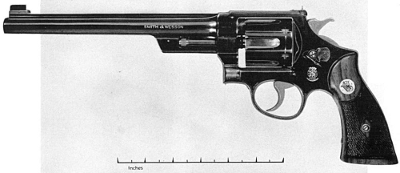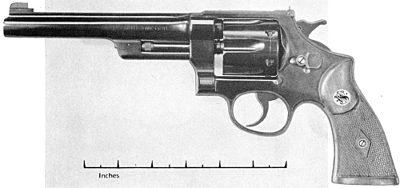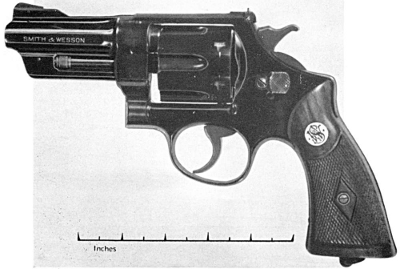The following information on the Smith & Wesson Magnum .357 comes from Smith & Wesson Hand Guns by Roy C. McHenry and Walter F. Roper. Smith & Wesson Hand Guns is also available to purchase in print.
One might have thought that Major Wesson would have been content to rest on the notable success of his .38/44, but he wasn’t. The Colt .38 Superautomatic’s superiority of a few second-feet and foot-pounds over the .38/44 rankled and he kept on experimenting with the ballistics of what had been the .38 Special. Finally he called on the outside assistance of Elmer Keith, who has been mentioned before in these pages.
They decided that the weight of the bullet and the powder space in the case were sufficient, and concentrated on increasing the charge until they had produced a cartridge with a velocity of 1,515 f.s. and a muzzle energy of 807 foot pounds—far beyond the ballistics of any existing pistol or revolver cartridge. Then they designed a bullet of square-shouldered type which tore a huge chunk of flesh from any animal tissue it encountered.
Tests showed that heat-treated cylinders would withstand the heavy blast, but that the old recoil bogey had appeared again. A new revolver had to be designed so that the cartridge could be fired with any degree of comfort.
Retaining the general lines of the .44 and without noticeably changing its proportions, they added metal here and there and finally restored the top rib to the barrel which had been abandoned on heavy Smith & Wesson arms with the .44 Russian Model. With an 8 1/2-inch barrel, these alterations ran the weight of the new revolver to 47 ounces, a figure which had not been equaled since the days of the Colt Dragoon. Subsequent tests showed that it could be fired with reasonable comfort and accuracy with a 3 1/2-inch barrel and a weight of 42 ounces.

The new model was christened the Magnum and was chambered to permit the use of the ordinary .38 Special cartridge as well as the new .38. But to avoid the deplorable results that would follow if the new cartridge were loaded by mistake into an ordinary .38 Special, the case was lengthened slightly so that it could not be inserted into the chamber.
When all this had been done, Major Wesson took one of the new Magnum revolvers out west and proceeded to kill an elk with it at a range considered extreme for a high-power rifle. Several deer were added to the bag before he returned to Springfield, and the following year he killed a grizzly!

In its original form, the Magnum had the undesirable feature of the narrow frame knuckle at the top of the grip, but a new grip was designed completely covering the knuckle and preventing it from digging into the web between the shooter’s thumb and forefinger when the gun was fired. This new grip is used on all heavy Smith & Wesson revolvers.
The Magnum makes a fine target weapon. With its own particular cartridge, you can run up a good score at 100 yards if your hand is steady enough. Using a two-handed grip, you can score consistently at longer distances. Everything depends on the technique of sighting and trigger squeeze.
As a man-stopper, the Magnum is deadly. A wallop that will knock over a bull elk will take all the fight out of a man if he is hit in the arm or leg. Agents of the F.B.I. are particularly fond of the weapon, though they prefer the short-barreled type which is easier to carry and draw. Many civilians like the gun for 50-yard shooting with ordinary .38 Special cartridges on account of its weight. This combination produces no more recoil than if you were shooting a .22.

The .38/44 cartridge has the same external dimensions as the .38 Special and it, of course, also can be used in the Magnum. If you want to soft-pedal your target practice you can use the wad cutter bullet and a reduced charge. Magnums can only be purchased on special order and an appropriate record of each transaction is made at the factory.
As it is impossible to lay restrictions on the arm in which a cartridge is to be used, the Colt Corporation soon began to produce New Service and Frontier Models chambered to take the Magnum cartridge. Gun for gun, these run slightly lighter than the Smith & Wessons.
The Magnum cartridge is the most powerful ever designed for a hand gun and will likely remain so for some time. While it would be possible to develop one of higher velocity or greater energy, the gun that would chamber it and fire it without excessive recoil would be so heavy that no shooter could hold it at arm’s length and fire it with any accuracy.
